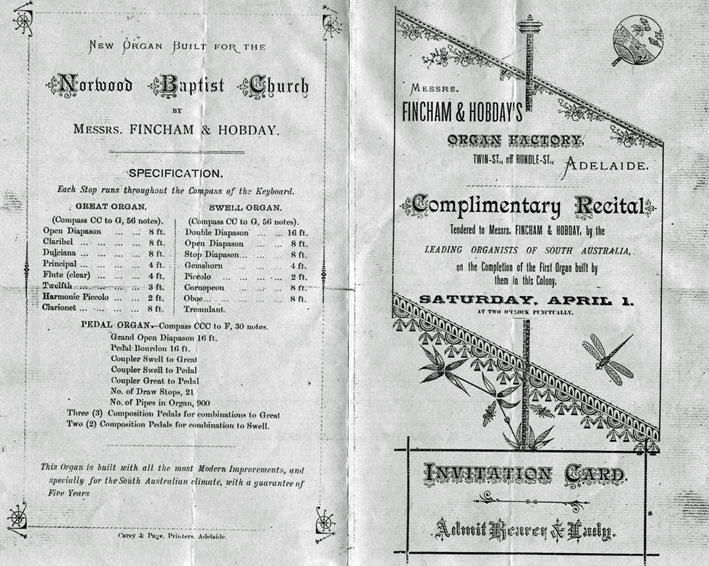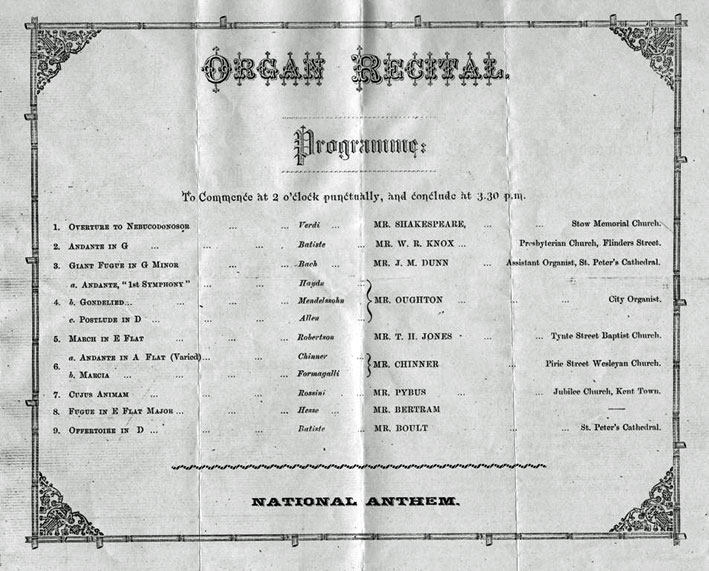
Photo: John Maidment (August 2011)

Photo: John Maidment (August 2011)
Historical and Technical Documentation by John Maidment
© OHTA (last updated September 2011)
The former Baptist Church, Norwood is a substantial stone building in the classical style erected in 1869, its architectural idiom influenced by Spurgeon's Tabernacle, Newington Butts, London.1 The architect was James Cumming.2
The building was described as follows, at the time of the laying of the foundation stone:
We append the following description of the building, published by us some time ago:— The building will be after the classic style, and its dimensions inside are to be 66 by 44, the height to the ceiling being 33 feet. The front will be relieved by a vestibule and porches. The ceiling will be coved and have coffered panels. Ventilation will be provided for by a large perforated panel placed in the centre of the ceiling, through which the air will pass by a large shaft to a louvred ventilator on the top of the roof, and this is to be so arranged as to be closed at will. The exterior will be composed of freestone random work, with dressings of Portland cement. The walls inside will be of rough stucco, and all the architraves and ornaments of the interior are to be of white plaster or Keene's cement. The pews and doors will be of yellow American pine, with Huon pine panels, and some stained work, and will be partly French polished and partly varnished. The arrangement of the seats is semi-circular for one-half the area; the platform, in which is the baptistry, being also of similar form. Convenient vestries will be erected at the rear of the structure. The church, it is estimated, will comfortably seat 512 persons. Mr. Charles Farr will be the builder, the contract price being £2,489, exclusive of glass, gas fittings, fencing, sheds. &c; the cost of which with the price of the land will raise the total amount to about £3,100.3
In 1882 Fincham & Hobday built its first organ for a church in South Australia from its recently-opened Adelaide premises in Twin Street. A recital was given on the organ in the factory by several of Adelaide's leading organists on Saturday 1 April 1882 and the programme for this appears below:


The recital received an extensive write up in the local newspapers:
ORGAN RECITAL — Messrs. Fincham and Hobday having just completed the building of a new organ to be erected in the Norwood Baptist Church, a complimentary recital was accorded to them on Saturday at their factory in Twin-street by several of the leading organists of the pity. A large number of invitations were issued, and the room, which will, we should think, seat 200 persons, was almost full. ...
The front has a handsome appearance, and though the acoustic properties of the warehouse are not such as to display the qualities of the organ to the best advantage, we are sure that there can be but one opinion, as to its excellence, both in regard to its power and the purity of its tone. The organists who took part in the recital were Messrs. Shakespeare, Knox, Dunn, Jones, Chinner, Pybus, Bertram, and Boult. Mr. Oughton, whose name was on the programme, was unavoidably absent. As the object of the gathering was not, we presume, to display the talents of the several gentlemen we have named, but rather to test the capabilities of the instrument itself, we need not refer in detail to the performances. The selections were from such composers as Verdi, Batiste, Bach, Rossini, Hesse, and others, and were evidently made with a view to the efficient display of the organ. It may perhaps be thought that in some respects the tone of the instrument is better adapted for a concert hall than for a place of worship, but it must be remembered that even the most sacred music is all comprehensive in its utterances, including the expression of 'joy and gladness, thanksgiving, and the voice of melody, and of consequence in an organ of any pretensions to completeness provision must be made for the appropriate embodiment of every variety of emotion. Without this provision it would be impossible to convey any adequate idea of the noble conceptions of the great composers of ecclesiastical music. We may mention that the organ is entirely of colonial manufacture, every part of it, including the castings, having been made either here or in Melbourne.4
The organ was installed shortly afterwards at the Baptist Church, Norwood, a building with excellent acoustics. The casework was unusual, with the signature Fincham three towers, but flanked here by curved side flats (possibly inspired by the Hill & Son organ in Adelaide Town Hall), and the pipes unsupported by transom rails.
Later, it was sympathetically enlarged in 1897 by J.E. Dodd who also extended the console to the front of the rostrum. A local newspaper reported as follows:
The alterations to the Church comprise a new organ-chamber and choir recess of magnificent proportions, viz.:— 25ft. deep, 23 ft. wide, and 30 ft. high. This is placed at the back of the building, and special attention has been paid to its acoustic properties with most satisfactory results, as now both choir and organ may be heard to the best advantage in aII parts of the Church. The whole of the interior of this chamber is coloured and finished with plaster mouldings and ornaments in harmony with the rest of the building, which is now able to accommodate some seventy or more persons than before. Special interest attaches to this organ, as it was the first one constructed by our local firm, Messrs. Fincham & Hobday, now J.E. Dodd, and was built by them some fifteen years ago. The instrument when first placed in the Church contained only seventeen speaking stops distributed over two manuals and pedal. It is now enlarged to twenty-one speaking stops distributed as before. …
The only new stop in the great organ is the "Lieblich gedacht", which is of metal and of very fine quality. It is put in the place of a twelfth, which has now been done away with. A small new soundboard has been added at the back of the swell to carry the four new stops, and the swellcase has been enlarged so us to enclose all the new work. In place of a piccolo, which the swell formerly contained, a now 4-ft. flute has been introduced. Of the other new stops, at present only the "viole d'orchestra" and "celeste" are in, the others having not yet arrived, though they are expected within a few days, and will be placed in position immediately. The tone of the "viole d'orchestra," which is of the latest construction and design, is fine indeed, and might be easily mistaken for a violin; while when used in combination with the "celeste" the effect is charming. The "console" has been moved from the main body of the instrument, and now stands some 10 ft in front of it — an excellent arrangement by which the organist is enabled to exercise complete control over his choir, and also to absolutely judge of the effect of his own performance. This detached "console" necessitates a number of somewhat intricate mechanical appliances; in the pre sent case the entire mechanism is nearly equal to a mile in length, and it is no small tribute to the excellence of our local firm's work that though the most severe and exacting tests wore imposed upon the instrument both on Sunday and Tuesday evening there was not the suspicion of a fault discernible. Added to this, the whole of the stops have been freshly regulated, and in many cases vastly improved as regards tone and power. The whole of the work reflects the highest credit on Mr. J.E. Dodd.5
The specification of the organ after 1897 was:
| GREAT Open Diapason Claribel Lieblich Gedact Dulciana Principal Flute Harmonic Piccolo Clarionet Swell to Great SWELL Double Diapason Open Diapason Stop Diapason Viol d'Orchestre Vox Celeste Gemshorn Flute Gedact Piccolo Cornopean Oboe Vox Humana Tremulant PEDAL Open Diapason Bourdon Great to Pedal Swell to Pedal |
8 8 8 8 4 4 2 8 16 8 8 8 8 4 4 2 8 8 8 16 16 |
1897, replacing original Twelfth 3 later enclosed in its own swell box added 1897 added 1897 added 1897 added 1897 |
Compass: 56/30
Mechanical key and stop action
3 composition pedals to Great
2 composition pedals to Swell
Balanced swell pedal
[Lever pedal for Clarionet?]6
This instrument remained in its 1897 state, retaining its mechanical key and stop actions, console, fine casework and splendidly decorated façade pipes. It is quite a visual spectacle, located in its lofty apse chamber and the plaster ceiling above decorated with stars.
The church was sold some years ago and is now a bookshop and cafe. A recent inspection of the interior revealed that the extended mechanical action console had been severed from the instrument and stored behind a plasterboard wall erected in front of the instrument. This is a very sad ending as this very fine organ is unlikely ever to be heard again. It is not known whether this work was permitted under heritage guidelines. The instrument was one of the most significant in South Australia.7
1 John Whitehead, Adelaide City of Churches: a Jubilee 150 Survey. Magill, SA: Magill Publications, 1986, p.134
2 South Australian Advertiser, 13 December 1869, p.3
3 South Australian Register, 16 April 1869, p.3
4 South Australian Register, 3 April 1882, p.4
5 South Australian Register, 24 February 1897, p.6
6 Recorded by John Maidment 1969
7 Inspection of the building 10 August 2011